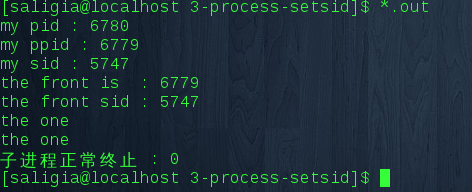关于在Linux 编程下的没有控制终端(子进程调用setsid() 后)的问题
0

#include <stdio.h>
#include <fcntl.h>
#include <sys/wait.h>
#include <signal.h>
#include <string.h>
#include <unistd.h>
#include <errno.h>
#include <stdlib.h>
inline void err_que(const char *msg)
{
puts(msg);
exit(0);
}
inline void err_sys(const char *msg)
{
printf("%s : %s \n", msg, strerror(errno));
exit(0);
}
void signo(int sig);
int main()
{
int pid;
char buf[20];
int len;
signal(SIGCHLD, signo);
signal(SIGTTOU, signo);
signal(SIGTTIN, signo);
if((pid = fork()) == -1)
err_sys("fork error");
else if(pid == 0)// 子进程
{
// 显示进程的一般信息
printf("my pid : %d\n", getpid());
printf("my ppid : %d\n", getppid());
printf("my sid : %d\n", getsid(0));
printf("the front is : %d\n", tcgetpgrp(STDOUT_FILENO));
printf("the front sid : %d\n", tcgetsid(STDOUT_FILENO));
// 建立一个新的会话
// 必须不是一个进程的进程组的组长, 建立成功后不分配控制终端
// 建立新会话后,该进程成为新进程组的组长进程,并且成为新会话>的会话首进程
setsid();
// open("dev/tty", O_RDWR);
// 向前台终端发送消息
fgets(buf, 20, stdin);
fputs(buf, stdout);
// sleep(15);
exit(0);
}
// 父进程
while(1)
pause();
return 0;
}
void signo(int sig)
{
int status;
if(sig == SIGCHLD)
{
waitpid(-1, &status, WCONTINUED | WUNTRACED | WNOHANG);
if(WIFEXITED(status))
{
printf("子进程正常终止 : %d\n", WEXITSTATUS(status));
exit(0);
}
else if(WIFSIGNALED(status))
{
printf("子进程接受到信号终止 : %d\n",WTERMSIG(status));
exit(0);
}
else if(WIFSTOPPED(status))
printf("子进程已经暂停 : \n", WSTOPSIG(status));
else if(WIFCONTINUED(status))
printf("子进程暂停后已经继续 ....\n");
}
else if(sig == SIGTTOU) // 写控制终端
{
printf("%d 尝试写控制终端\n", getpid());
}
else if(sig == SIGTTIN)
{
printf("%d 尝试读控制终端\n", getpid());
}
}

我想问的是为什么没有控制终端的进程还能正常输入输出??
最佳答案
0
输入输出使用的都是文件描述符012
收获园豆:10











